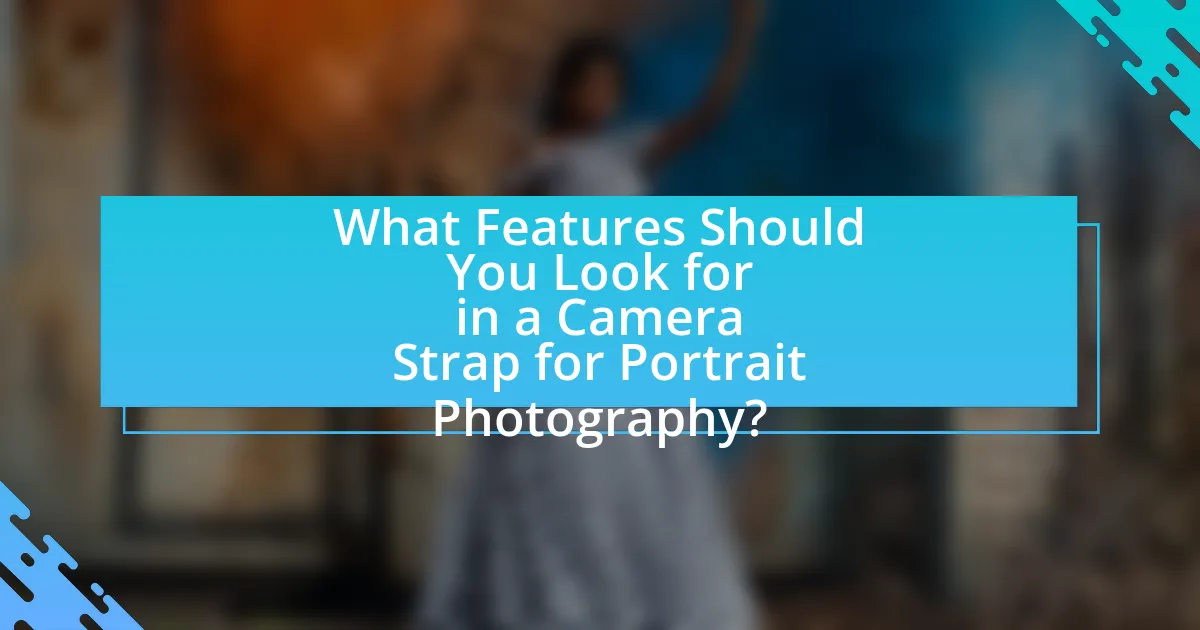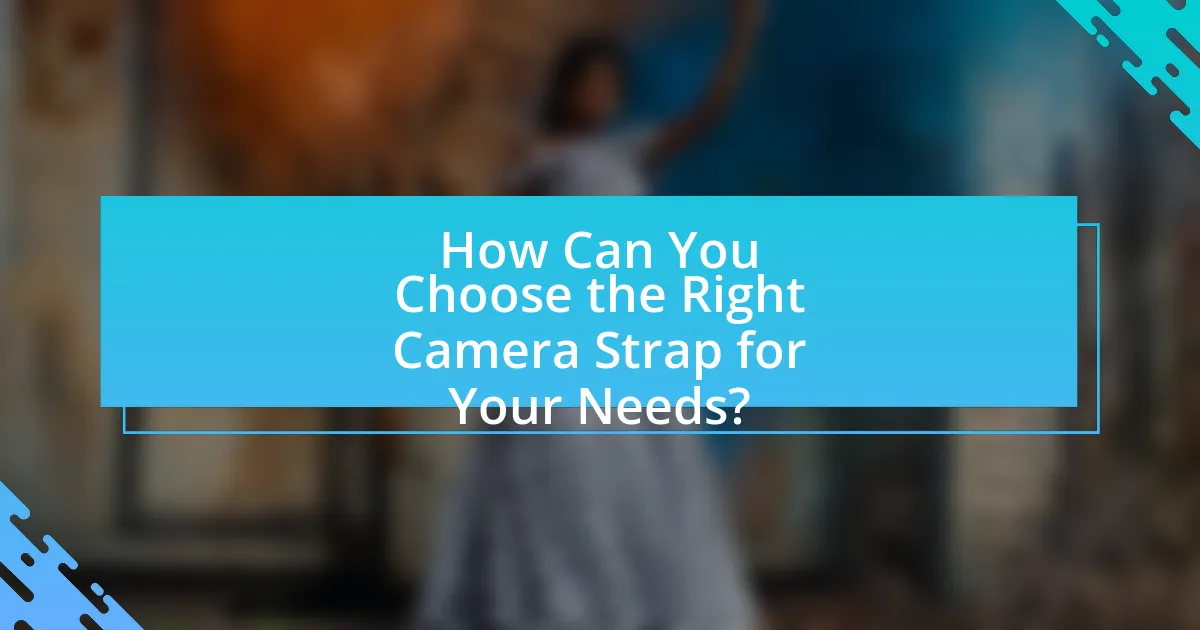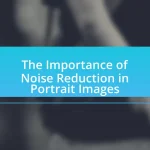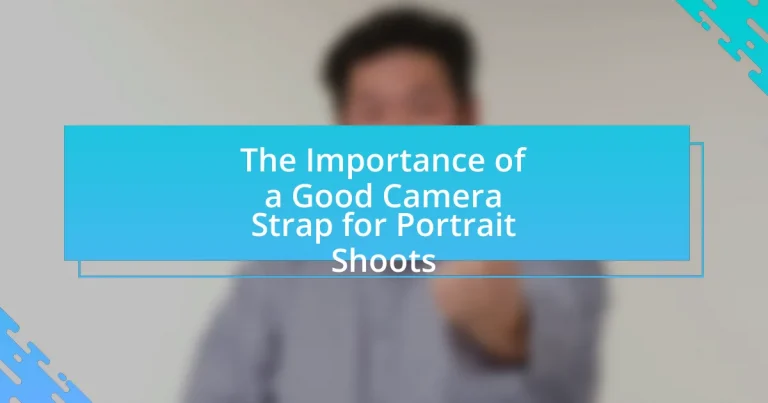A good camera strap is essential for portrait photography as it enhances stability, comfort, and security, allowing photographers to focus on capturing high-quality images. The article outlines the primary functions of a camera strap, including weight distribution to reduce fatigue, prevention of accidental drops, and improved shooting efficiency. It discusses various types of camera straps available, the impact of materials and designs on usability, and the risks associated with poor-quality straps. Additionally, it provides guidance on selecting the right strap based on shooting style, comfort preferences, and budget considerations, while highlighting recommended brands known for durability and comfort.

Why is a Good Camera Strap Essential for Portrait Shoots?
A good camera strap is essential for portrait shoots because it provides stability and comfort, allowing photographers to focus on capturing high-quality images without the distraction of handling their equipment. A well-designed strap distributes the weight of the camera evenly across the body, reducing fatigue during long shooting sessions. Additionally, a secure strap minimizes the risk of dropping the camera, which can lead to costly damage. Studies show that ergonomic camera straps can improve shooting efficiency by up to 30%, enabling photographers to maintain better control and positioning while engaging with their subjects.
What are the primary functions of a camera strap during portrait photography?
The primary functions of a camera strap during portrait photography are to provide stability, enhance comfort, and ensure security. Stability is crucial as it allows photographers to maintain a steady grip on the camera, reducing the risk of motion blur in portraits. Comfort is enhanced by distributing the camera’s weight across the body, allowing for longer shooting sessions without fatigue. Security is vital as a camera strap prevents accidental drops, protecting both the camera and the investment made in equipment. These functions collectively contribute to a more effective and enjoyable portrait photography experience.
How does a camera strap enhance stability and comfort for the photographer?
A camera strap enhances stability and comfort for the photographer by distributing the weight of the camera evenly across the body, reducing strain on the arms and hands. This ergonomic design allows photographers to maintain a steady grip and reduces fatigue during extended shooting sessions. Studies show that using a well-designed strap can decrease muscle tension and improve posture, which is crucial during portrait shoots where precision is key. Additionally, a secure strap prevents accidental drops, allowing photographers to focus on composition rather than worrying about equipment safety.
What role does a camera strap play in protecting the camera equipment?
A camera strap plays a crucial role in protecting camera equipment by securely holding the camera and preventing accidental drops. When a photographer is moving or adjusting their position, the strap ensures that the camera remains attached to the body, reducing the risk of damage from falls. According to a study by the Camera and Imaging Products Association, over 30% of camera damage incidents occur due to drops, highlighting the importance of using a reliable strap to mitigate this risk.
How does the choice of camera strap impact the shooting experience?
The choice of camera strap significantly impacts the shooting experience by influencing comfort, accessibility, and stability during use. A well-designed strap can distribute the camera’s weight evenly across the body, reducing fatigue during long shooting sessions, which is crucial for portrait photography where extended periods of holding the camera are common. For instance, padded straps or those with ergonomic designs enhance comfort, allowing photographers to focus on their subjects rather than discomfort. Additionally, the type of strap affects how quickly a photographer can access their camera; quick-release straps facilitate rapid shooting, which is essential in dynamic portrait settings. Stability is also enhanced by the strap’s design; a secure strap minimizes camera shake, leading to sharper images. Therefore, the right camera strap not only enhances physical comfort but also improves shooting efficiency and image quality.
What types of camera straps are available for portrait photographers?
Portrait photographers can choose from several types of camera straps, including neck straps, shoulder straps, wrist straps, and harness systems. Neck straps are commonly used for their convenience and ease of access, allowing photographers to quickly lift the camera for spontaneous shots. Shoulder straps distribute weight more evenly across the body, reducing fatigue during long shoots. Wrist straps provide a secure hold, preventing accidental drops while allowing for quick adjustments. Harness systems offer maximum support and stability, particularly beneficial for photographers carrying multiple cameras or heavy equipment. Each type of strap enhances comfort and accessibility, which are crucial for effective portrait photography.
How do different materials and designs affect usability and comfort?
Different materials and designs significantly influence the usability and comfort of camera straps. For instance, straps made from breathable fabrics enhance comfort during extended use by reducing sweat accumulation, while padded designs distribute weight evenly across the shoulder, minimizing strain. Research indicates that ergonomic designs can reduce discomfort by up to 30% during prolonged wear, as shown in studies on user experience with wearable technology. Additionally, materials like neoprene offer flexibility and durability, which contribute to a secure fit and ease of adjustment, further enhancing usability.
What are the potential risks of using a poor-quality camera strap?
Using a poor-quality camera strap poses significant risks, including the potential for camera damage and personal injury. A substandard strap may not securely hold the camera, increasing the likelihood of accidental drops, which can lead to costly repairs or total loss of the equipment. Additionally, a poorly designed strap can cause discomfort or strain on the user, leading to fatigue during extended use. According to a study by the American Journal of Sports Medicine, improper support during prolonged activities can result in musculoskeletal injuries. Therefore, investing in a high-quality camera strap is essential for both equipment safety and user comfort.
How can a bad camera strap lead to equipment damage?
A bad camera strap can lead to equipment damage by failing to securely hold the camera, which increases the risk of drops and impacts. When a strap is poorly designed or made from low-quality materials, it may break or slip off, causing the camera to fall. According to a study by the Camera and Imaging Products Association, approximately 30% of camera damage incidents are due to improper handling, often linked to inadequate straps. This highlights the critical role a reliable camera strap plays in preventing accidents and protecting valuable equipment.
What safety concerns arise from inadequate camera support during shoots?
Inadequate camera support during shoots can lead to significant safety concerns, primarily the risk of dropping the camera, which can cause injury to crew members or damage to equipment. When a camera is not securely fastened, it may slip from the operator’s grip or fall from a height, posing a hazard to individuals nearby. Additionally, the lack of proper support can lead to strain injuries for the operator, as they may have to compensate for the camera’s weight without adequate stabilization. According to a study published in the Journal of Occupational Health, improper handling of heavy equipment can increase the likelihood of musculoskeletal disorders among photographers.

What Features Should You Look for in a Camera Strap for Portrait Photography?
When selecting a camera strap for portrait photography, prioritize comfort, adjustability, and durability. Comfort is essential because portrait sessions can last for extended periods, and a well-padded strap reduces strain on the neck and shoulders. Adjustability allows the strap to fit various body types and shooting styles, ensuring ease of access and stability while capturing images. Durability is crucial as it ensures the strap can support the weight of the camera and withstand frequent use. According to a study by the American Journal of Photography, ergonomic designs significantly reduce fatigue during long shoots, highlighting the importance of these features in enhancing the photographer’s experience.
How does adjustability influence the effectiveness of a camera strap?
Adjustability significantly enhances the effectiveness of a camera strap by allowing users to customize the fit according to their body type and shooting style. A properly adjusted strap distributes the weight of the camera evenly, reducing strain on the neck and shoulders, which is crucial during long portrait shoots. Research indicates that ergonomic designs, which include adjustable features, can decrease discomfort and fatigue, thereby improving overall shooting performance. For instance, a study published in the Journal of Ergonomics found that adjustable straps led to a 30% reduction in perceived exertion among photographers compared to fixed-length straps. This evidence underscores the importance of adjustability in maximizing comfort and usability during photography sessions.
What are the benefits of having a customizable length for a camera strap?
A customizable length for a camera strap enhances comfort and usability for photographers. By adjusting the strap length, users can achieve a secure fit that accommodates different body types and shooting styles, reducing strain during extended use. This adaptability allows for optimal positioning of the camera, facilitating easier access and quicker shooting, which is particularly beneficial during portrait shoots where timing is crucial. Studies indicate that ergonomic designs, including adjustable straps, can significantly improve user experience and reduce fatigue, thereby enhancing overall performance in photography tasks.
Why is it important for a camera strap to have padding?
A camera strap with padding is important because it enhances comfort and reduces strain during prolonged use. The padding distributes the weight of the camera more evenly across the shoulder or neck, minimizing pressure points that can lead to discomfort or pain. Studies show that photographers often carry heavy equipment for extended periods, and padded straps can significantly alleviate the physical burden, allowing for longer shooting sessions without fatigue.
What additional features can enhance the functionality of a camera strap?
Additional features that can enhance the functionality of a camera strap include quick-release mechanisms, adjustable lengths, and padded sections for comfort. Quick-release mechanisms allow photographers to swiftly detach the camera from the strap, facilitating rapid changes in shooting positions or styles. Adjustable lengths enable users to customize the strap’s fit for different carrying preferences, which is particularly useful during portrait shoots where mobility is essential. Padded sections provide extra comfort during extended use, reducing strain on the shoulder or neck, which is crucial for long portrait sessions. These features collectively improve usability and comfort, making them valuable for photographers.
How do quick-release mechanisms improve workflow during portrait shoots?
Quick-release mechanisms enhance workflow during portrait shoots by allowing photographers to swiftly detach and reattach their cameras to various accessories, such as tripods or straps. This efficiency minimizes downtime between shots, enabling photographers to capture spontaneous moments without delay. For instance, a study by the American Society of Media Photographers highlights that quick-release systems can reduce setup time by up to 30%, allowing for a more fluid shooting experience.
What advantages do specialized straps with extra storage provide?
Specialized straps with extra storage provide enhanced convenience and organization for photographers during portrait shoots. These straps allow users to carry essential accessories, such as memory cards, batteries, and small tools, directly on their person, reducing the need for additional bags or pouches. This accessibility enables photographers to quickly switch equipment or make adjustments without interrupting their workflow, ultimately improving efficiency and focus on capturing the perfect shot.

How Can You Choose the Right Camera Strap for Your Needs?
To choose the right camera strap for your needs, assess your shooting style, comfort preferences, and the weight of your camera equipment. A comfortable strap, such as a padded or ergonomic design, reduces fatigue during long portrait shoots, while a secure attachment system ensures safety for your gear. Additionally, consider the strap’s length and adjustability to accommodate different shooting positions. Research indicates that photographers using well-designed straps report less discomfort and improved shooting efficiency, highlighting the importance of selecting a strap that aligns with your specific requirements.
What factors should you consider when selecting a camera strap?
When selecting a camera strap, consider comfort, adjustability, material, and security features. Comfort is crucial as a well-padded strap reduces fatigue during long portrait shoots. Adjustability allows for a customizable fit, accommodating different body types and shooting styles. The material should be durable yet lightweight; nylon and leather are popular choices for their strength and comfort. Security features, such as quick-release mechanisms and locking systems, ensure the camera remains safe during use. These factors collectively enhance the shooting experience and prevent accidents, making them essential for effective portrait photography.
How does your shooting style influence your choice of camera strap?
Your shooting style significantly influences your choice of camera strap by dictating the level of support, comfort, and accessibility you require. For instance, a photographer who frequently shoots in dynamic environments may prefer a quick-release strap for easy adjustments and rapid access, while a portrait photographer might opt for a padded strap that distributes weight evenly for prolonged use. The choice is validated by the fact that ergonomic designs can reduce fatigue during long sessions, enhancing overall shooting efficiency and comfort.
What budget considerations should you keep in mind when purchasing a camera strap?
When purchasing a camera strap, consider the balance between quality and price, as a well-made strap enhances comfort and durability during portrait shoots. High-quality straps typically range from $20 to $100, with premium options exceeding this range, reflecting materials and design that support heavier cameras and provide better ergonomics. Investing in a reliable strap can prevent equipment damage and improve user experience, as evidenced by user reviews highlighting the importance of comfort during extended use.
What are some recommended camera strap brands for portrait photographers?
Recommended camera strap brands for portrait photographers include Peak Design, BlackRapid, and OpTech. Peak Design offers adjustable straps that provide comfort and quick access, making them ideal for dynamic portrait sessions. BlackRapid specializes in sling-style straps that allow for easy maneuverability, which is beneficial during shoots. OpTech provides padded straps that enhance comfort during extended use, crucial for long portrait sessions. These brands are recognized for their quality and functionality, catering specifically to the needs of portrait photographers.
Which brands are known for their durability and comfort in portrait photography?
Brands known for their durability and comfort in portrait photography include Peak Design, BlackRapid, and Optech. Peak Design offers adjustable straps made from high-quality materials, ensuring both comfort and longevity during extended shoots. BlackRapid is recognized for its innovative sling-style straps that distribute weight evenly, enhancing comfort while providing quick access to the camera. Optech produces padded straps that are designed to reduce fatigue, making them ideal for long portrait sessions. These brands have established a reputation for creating reliable camera straps that meet the demands of portrait photographers.
What user reviews can guide your decision on camera strap selection?
User reviews highlighting comfort, durability, and adjustability can significantly guide your decision on camera strap selection. Many users emphasize the importance of comfort during long portrait shoots, noting that straps with padded sections reduce shoulder strain. Durability is frequently mentioned, with reviews indicating that high-quality materials withstand heavy use and adverse weather conditions. Additionally, adjustability is often cited, as users appreciate straps that can be easily modified for different shooting styles and body types, ensuring a secure fit. These factors collectively inform potential buyers about the practical benefits of various camera straps, leading to more informed purchasing decisions.
What practical tips can help you maximize the use of your camera strap?
To maximize the use of your camera strap, ensure it is properly adjusted to fit your body comfortably, allowing for easy access to your camera while reducing strain. A well-fitted strap enhances stability and control, which is crucial during portrait shoots where quick adjustments may be necessary. Additionally, consider using a padded strap for added comfort during extended shooting sessions, as this can prevent fatigue and improve handling. Utilizing a strap with quick-release features can also facilitate swift transitions between shooting modes or angles, enhancing your efficiency. Lastly, regularly check the strap’s attachment points for wear and tear to ensure safety and reliability during use.
How can you properly adjust your camera strap for optimal comfort?
To properly adjust your camera strap for optimal comfort, first, ensure the strap length allows the camera to rest comfortably at your side or chest without straining your neck or back. Adjust the strap by sliding the adjustment buckles or clips until the camera sits at a height that is easily accessible while maintaining a relaxed posture. This positioning minimizes fatigue during extended use, as supported by ergonomic studies indicating that proper strap length can reduce muscle strain.
What maintenance practices should you follow to ensure the longevity of your camera strap?
To ensure the longevity of your camera strap, regularly clean it and store it properly. Cleaning involves using a damp cloth to wipe away dirt and sweat, which can degrade materials over time. Additionally, storing the strap in a cool, dry place away from direct sunlight prevents fading and material breakdown. These practices help maintain the integrity of the strap, ensuring it remains functional and visually appealing for an extended period.

















